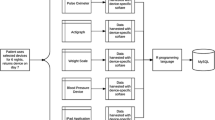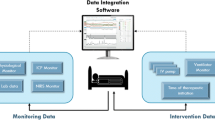Abstract
16 experienced ICU nurses monitored simulated central station VDU displays for the occurrence of ectopic beats and for signs of deterioration in general cardiovascular status. Each period of monitoring lasted for 1 h, and on separate occasions each nurse monitored 1, 2, 4 or 6 displays simultaneously. For primary clinical tasks, the data showed that the nurses' performance improved with each test. The identification of ventricular ectopic beats (VEBs) improved within the 1 h of each test except when 6 screens were being viewed simultaneously, with a similar result for the identification of deterioration of cardiovascular status. The nurses showed a marked preference for analogue signals over digits for the identification of VEBs. The highest priority clinical task was the identification of deteriorating cardiovascular status. When this task was performed efficiently less attention was given to minor tasks, and the nurse rated herself as very tired.
Similar content being viewed by others
References
Casey E, Wickens CD (1986) Visual display representation of multidimensional systems: the effect of information correlation and display integrality. Techn Rep CPC-86-2. Prepared for the US Army Res Inst
Crew AD, Stoodley KDC, Naghdy F, Unsworth GD (1984) Preliminary studies in the identification of cardiac status in a cardiac surgical intensive therapy unit. Intensive Care Med 10:71–78
Crew AD, Old S, Craig A, Unsworth GD, Fletcher PC (1989) central station data displays: an experimental evaluation of observer performance. Part 1. Number of displays and observation time. Intensive Care Med 15:314–318
Jacob RJK, Egeth HE, Bevon W (1986) The face as a data display. Hum Factors 18:189–200
Naghdy F, Stoodley KDC, Henry RM, Crew AD (1984) Development of a microprocessor-based monitoring system for postsurgical cardiac patients. J Microcomp App 7:41–49
Stoodley KDC; Naghdy F, Crew AD (1982) Monitoring of cardiovascular variables in a post-surgical cardiac intensive care unit. In: Anderson OD (ed) Time series analysis: theory and practice I. North-Holland, Amsterdam Oxford New York, pp 123–137
Stoodley KDC, Lu R, Crew AD, Henry RM (1984) A microprocessor-based immediate alarm system for post-surgical cardiac patients. In: Quetglas GM, Macfarlane PW, Perez de Talens AF, Aguilar JC (eds) The application of computers in cardiology: state of the art and new perspectives. Elsevier (North-Holland), Amsterdam, pp 385–388
Wickens CD (1987) Attention. In: Hancock PA (ed) Human factors psychology. Elsevier (North-Holland), Amsterdam
Winer BJ (1962) Statistical principles in experimental design. McGraw-Hill, NY
Woods DD, Wise JA, Hanes LF (1981) An evaluation of nuclear power plant safety parameter display systems. Proc Hum Factors Soc 25:110–114
Author information
Authors and Affiliations
Rights and permissions
About this article
Cite this article
Crew, A.D., Old, S., Craig, A. et al. Central station data displays: an experimental evaluation of observer performance. Intensive Care Med 15, 379–384 (1989). https://doi.org/10.1007/BF00261497
Received:
Accepted:
Issue Date:
DOI: https://doi.org/10.1007/BF00261497




